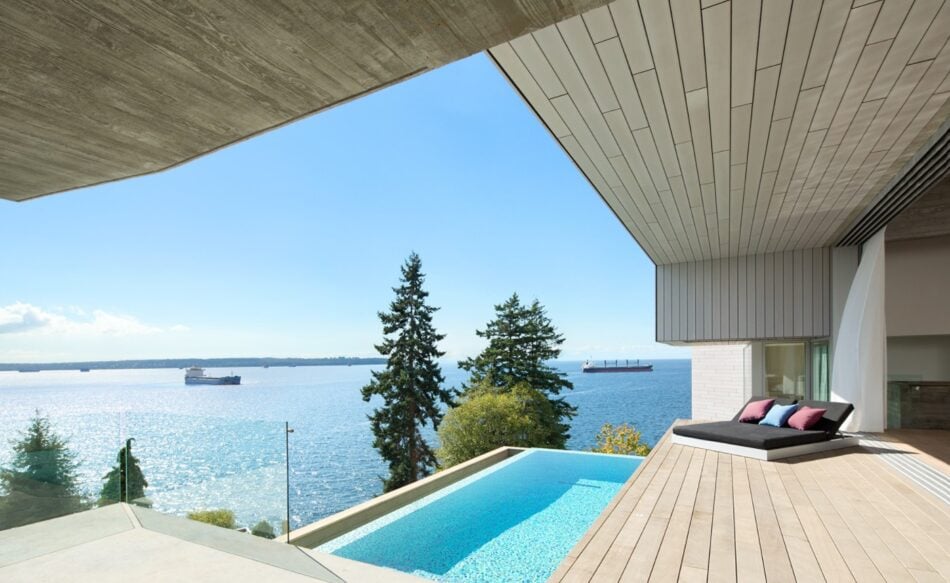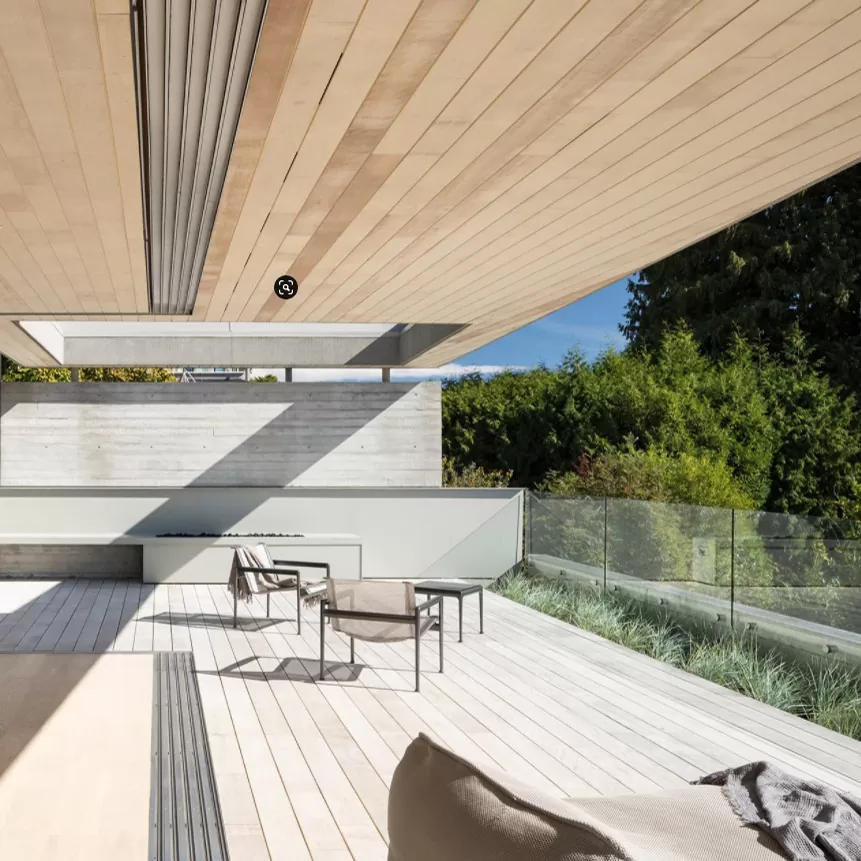
5 Ways to Transform Your Outdoor Space With Decking by HOUZZ
Make the most of your garden, expand living space and cut down on maintenance with natural wood decking
02.06.2021

Warm weather means spending more time outdoors, a season to enjoy relaxing in the garden on a sunny afternoon or getting together with friends for a meal outside. If you’re looking to better set up your outdoor space, whatever its size, a wood decking can add attractive square footage for lounging, cooking, dining, entertaining and even working. The most dramatic decks can show off your home’s architecture and boost the overall look of your outdoor space.
“Decks are a great extension to an interior living space and can extend the feeling of interior space,” says architect Lisa Bovell, principal architect at McLeod Bovell Modern Houses in Vancouver. Read on to discover five ways that adding natural wood decking can enhance your outdoor space and lifestyle, and learn the advantages of choosing natural, highly durable and sustainably sourced wood as a decking material.

1. Boost Your Outdoor Living Space
Natural wood decking is an ideal transition from your home’s interior to the outdoors. “Decks are a great way to create a seamless connection between the interior and the exterior if the colour of the hardwood flooring on the interior matches the deck beyond,” Bovell says. For this stunning home in West Vancouver designed by McLeod Bovell Modern Houses, the deck’s blonde hue corresponds with the light-toned flooring inside, both a beachy complement to the blue waters of the pool and the inlet beyond. Bovell’s team used board-formed concrete for the siding, which has a softwood grain texture that mimics the natural wood of the decking.
For this project, Bovell selected acetylated wood for the decking — a material chosen carefully to stand up to the climate of the site. Acetylating changes the cell structure of the wood so the cell walls block moisture, reducing the wood’s ability to absorb water. This results in nontoxic wood that’s naturally water- and insect-resistant, is barefoot-friendly and is safe for people and pets.
“We found this product after searching for a replacement for natural wood alternatives for decking material in the challenging climate that is the West Coast of British Columbia,” Bovell says. “Accoya wood is a good choice of wood for the West Coast because there are not any other durable wood options that are hard enough for a durable deck surface.” Additionally, the wood offered by Accoya is sustainably sourced, with a smaller environmental footprint than other decking materials.

2. Enhance Your Home’s Architectural Features
Wood decking is a good choice for any home style, traditional to modern. Whether the wood is light or dark, the surface textured or smooth, decking can complement and enhance the architectural features of your home. One of the best things about natural wood, Bovell says, is the variation in colour and texture between and within planks. “We find that this natural variation creates enough ‘noise’ and beauty as it is, so we try very hard to find a single wood that can be used in all applications and locations — horizontal siding, vertical decking, on soffits, sometimes on ceilings,” she says.
The architects used Accoya wood for the decking, soffit, exterior siding and exterior window screens of this contemporary West Vancouver home. Using the same material for all of these applications enhanced the minimalist look they were after, bringing the focus to the clean lines of the building and the gorgeous view. Choosing a material that would work both indoors and out and stand up to weather exposure was essential to the integrated style.

3. Complement Your Yard
Even if you have a modest-size home, wood decking is a natural companion to any style of landscape or even a view looking out to leafy canopies. At home alongside lawns, flower beds, shrubs and trees, wood decking provides a calming neutral palette for colourful gardens and looks harmonious with green landscaping. Grey is an on-trend neutral colour for decking, letting a green lawn and colourful flowers really pop. One of the advantages of using natural wood decking is that the boards will naturally weather to a silvery grey. If you’re bringing greenery to your deck with potted plants, choosing acetylated wood reduces the chance of water stains left by the pots.
4. Express Your Personal Style
Options abound when it comes to colour stains and surface textures for wood decking. You can let your design taste shine with smooth, brushed, charred or even custom textured finishes for a one-of-a-kind look. Bovell prefers a wood’s more natural texture and focuses on stains. “The stain is usually matched to the wood scheme in the interior or exterior architecture and material palette of the house,” she says.
The slight variation in the boards and natural weathering can add subtle texture to an expanse of decking. Additionally, you might like to explore mixing wood decking with different hardscape materials such as cut stone, poured concrete or crunchy gravel, and choose a board colour and finish that ties them together visually. In the same way, Bovell selected a blonde hue to match the hardwood floors of the previously mentioned home, you could select decking to pick up the colours of natural stone in a flagstone path leading to a deck, for a similarly cohesive look.

5. Cut Down on Maintenance
When assessing your garden as a whole, consider the size of the planted areas, including lawns that need frequent mowing and flower beds that require tending, versus areas that are hardscaped. The time that goes into tending lawns or beds, not to mention the irrigation needed, often far exceeds time spent keeping a patio or deck clean and in good condition. So including some areas of decking can not only boost outdoor living space but also the time you have available to enjoy it.
That being said, any deck will need regular maintenance since it’s exposed to the elements. In general, you should sweep it regularly, clean it yearly, repair any damage, and stain or seal the wood surface when necessary. Accoya’s uncoated decks are particularly low-maintenance compared with other decking materials and are made from naturally rot-resistant wood. However, any wood is susceptible to weathering and sealing or staining can help protect it.
The wood acetylation process that changes the cell structure of Accoya’s wood improves the decking’s dimensional stability — the amount it expands and contracts —making it scratch-resistant, helping coatings last longer and requiring less maintenance. “Any stain product that is used tends to last longer on the surface of the material because the wood goes through less expansion and contraction, creating a better barrier to the elements,” Bovell says of Accoya wood decking.
More: To learn more about the benefits of Accoya’s sustainably sourced, acetylated wood decking and choose a style that complements your home and garden, visit our decking page here.
This story was written by the Houzz Sponsored Content team.
Where to Buy
You can buy Accoya and Accoya products from our selection of distributors or manufacturers in your region. Use our map search tool to find your nearest Accoya supplier.
WHERE TO BUY ACCOYA
for your next projectWhat type of Product are you interested in?
- - Select product type -
-
FIND A SUPPLIER
FIND A INSTALLER
for your next projectWhat type of are you interested in? (optional)
How will your be used?
- - Select type -
-
You are currently on the Accoya site
Would you like to visit the Accoya Site to view all relevant content for your location?